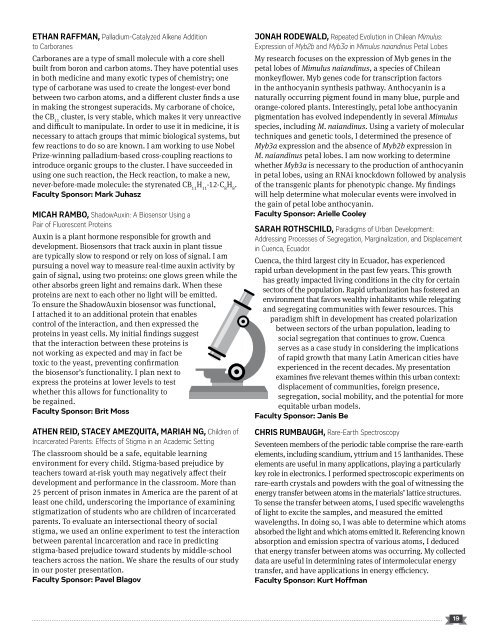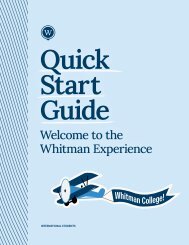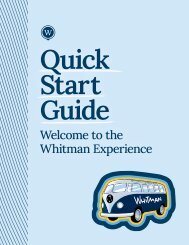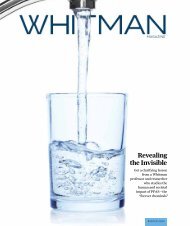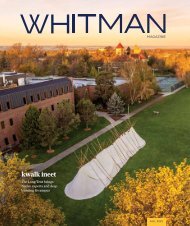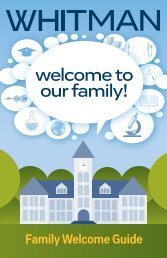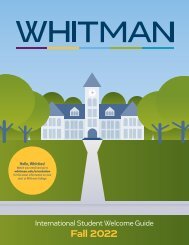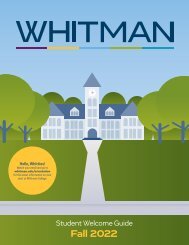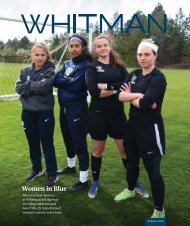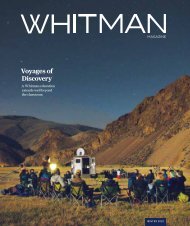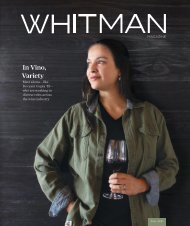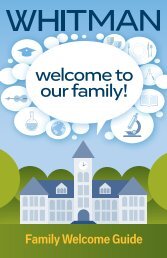Create successful ePaper yourself
Turn your PDF publications into a flip-book with our unique Google optimized e-Paper software.
ETHAN RAFFMAN, Palladium-Catalyzed Alkene Addition<br />
to Carboranes<br />
Carboranes are a type of small molecule with a core shell<br />
built from boron and carbon atoms. They have potential uses<br />
in both medicine and many exotic types of chemistry; one<br />
type of carborane was used to create the longest-ever bond<br />
between two carbon atoms, and a different cluster finds a use<br />
in making the strongest superacids. My carborane of choice,<br />
the CB 11<br />
cluster, is very stable, which makes it very unreactive<br />
and difficult to manipulate. In order to use it in medicine, it is<br />
necessary to attach groups that mimic biological systems, but<br />
few reactions to do so are known. I am working to use Nobel<br />
Prize-winning palladium-based cross-coupling reactions to<br />
introduce organic groups to the cluster. I have succeeded in<br />
using one such reaction, the Heck reaction, to make a new,<br />
never-before-made molecule: the styrenated CB 11<br />
H 11<br />
-12-C 8<br />
H 8<br />
.<br />
Faculty Sponsor: Mark Juhasz<br />
MICAH RAMBO, ShadowAuxin: A Biosensor Using a<br />
Pair of Fluorescent Proteins<br />
Auxin is a plant hormone responsible for growth and<br />
development. Biosensors that track auxin in plant tissue<br />
are typically slow to respond or rely on loss of signal. I am<br />
pursuing a novel way to measure real-time auxin activity by<br />
gain of signal, using two proteins: one glows green while the<br />
other absorbs green light and remains dark. When these<br />
proteins are next to each other no light will be emitted.<br />
To ensure the ShadowAuxin biosensor was functional,<br />
I attached it to an additional protein that enables<br />
control of the interaction, and then expressed the<br />
proteins in yeast cells. My initial findings suggest<br />
that the interaction between these proteins is<br />
not working as expected and may in fact be<br />
toxic to the yeast, preventing confirmation<br />
the biosensor’s functionality. I plan next to<br />
express the proteins at lower levels to test<br />
whether this allows for functionality to<br />
be regained.<br />
Faculty Sponsor: Brit Moss<br />
ATHEN REID, STACEY AMEZQUITA, MARIAH NG, Children of<br />
Incarcerated Parents: Effects of Stigma in an Academic Setting<br />
The classroom should be a safe, equitable learning<br />
environment for every child. Stigma-based prejudice by<br />
teachers toward at-risk youth may negatively affect their<br />
development and performance in the classroom. More than<br />
25 percent of prison inmates in America are the parent of at<br />
least one child, underscoring the importance of examining<br />
stigmatization of students who are children of incarcerated<br />
parents. To evaluate an intersectional theory of social<br />
stigma, we used an online experiment to test the interaction<br />
between parental incarceration and race in predicting<br />
stigma-based prejudice toward students by middle-school<br />
teachers across the nation. We share the results of our study<br />
in our poster presentation.<br />
Faculty Sponsor: Pavel Blagov<br />
JONAH RODEWALD, Repeated Evolution in Chilean Mimulus:<br />
Expression of Myb2b and Myb3a in Mimulus naiandinus Petal Lobes<br />
My research focuses on the expression of Myb genes in the<br />
petal lobes of Mimulus naiandinus, a species of Chilean<br />
monkeyflower. Myb genes code for transcription factors<br />
in the anthocyanin synthesis pathway. Anthocyanin is a<br />
naturally occurring pigment found in many blue, purple and<br />
orange-colored plants. Interestingly, petal lobe anthocyanin<br />
pigmentation has evolved independently in several Mimulus<br />
species, including M. naiandinus. Using a variety of molecular<br />
techniques and genetic tools, I determined the presence of<br />
Myb3a expression and the absence of Myb2b expression in<br />
M. naiandinus petal lobes. I am now working to determine<br />
whether Myb3a is necessary to the production of anthocyanin<br />
in petal lobes, using an RNAi knockdown followed by analysis<br />
of the transgenic plants for phenotypic change. My findings<br />
will help determine what molecular events were involved in<br />
the gain of petal lobe anthocyanin.<br />
Faculty Sponsor: Arielle Cooley<br />
SARAH ROTHSCHILD, Paradigms of Urban Development:<br />
Addressing Processes of Segregation, Marginalization, and Displacement<br />
in Cuenca, Ecuador<br />
Cuenca, the third largest city in Ecuador, has experienced<br />
rapid urban development in the past few years. This growth<br />
has greatly impacted living conditions in the city for certain<br />
sectors of the population. Rapid urbanization has fostered an<br />
environment that favors wealthy inhabitants while relegating<br />
and segregating communities with fewer resources. This<br />
paradigm shift in development has created polarization<br />
between sectors of the urban population, leading to<br />
social segregation that continues to grow. Cuenca<br />
serves as a case study in considering the implications<br />
of rapid growth that many Latin American cities have<br />
experienced in the recent decades. My presentation<br />
examines five relevant themes within this urban context:<br />
displacement of communities, foreign presence,<br />
segregation, social mobility, and the potential for more<br />
equitable urban models.<br />
Faculty Sponsor: Janis Be<br />
CHRIS RUMBAUGH, Rare-Earth Spectroscopy<br />
Seventeen members of the periodic table comprise the rare-earth<br />
elements, including scandium, yttrium and 15 lanthanides. These<br />
elements are useful in many applications, playing a particularly<br />
key role in electronics. I performed spectroscopic experiments on<br />
rare-earth crystals and powders with the goal of witnessing the<br />
energy transfer between atoms in the materials’ lattice structures.<br />
To sense the transfer between atoms, I used specific wavelengths<br />
of light to excite the samples, and measured the emitted<br />
wavelengths. In doing so, I was able to determine which atoms<br />
absorbed the light and which atoms emitted it. Referencing known<br />
absorption and emission spectra of various atoms, I deduced<br />
that energy transfer between atoms was occurring. My collected<br />
data are useful in determining rates of intermolecular energy<br />
transfer, and have applications in energy efficiency.<br />
Faculty Sponsor: Kurt Hoffman<br />
19


